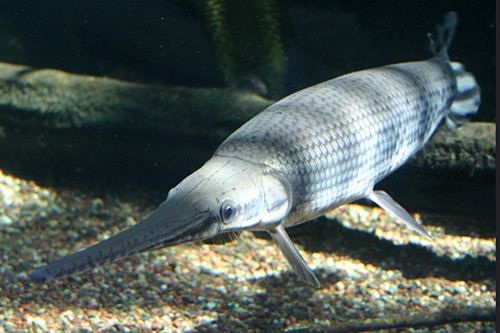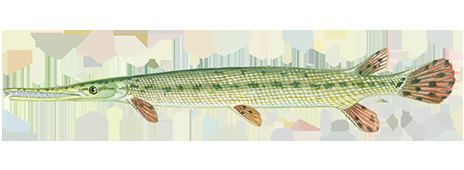Order Lepisosteiformes Rank Species | Phylum Chordata Family Lepisosteidae Higher classification Lepisosteus | |
 | ||
Found in Lake Winnipesaukee, Lake Wylie Similar Gar, Lepisosteus, Spotted gar, Alligator gar, Shortnose gar | ||
Longnose gar fishing 21 pounds 13 ounces and 52 inches long
The longnose gar (Lepisosteus osseus) is a primitive ray-finned fish of the gar family. It is also known as the needlenose gar. L. osseus is found along the east coast of North and Central America in freshwater lakes and as far west as Kansas and Texas and southern New Mexico. The gar have been present in North America for about 100 million years.
Contents
- Longnose gar fishing 21 pounds 13 ounces and 52 inches long
- Dolin s longnose gar fishing rig
- Distribution
- Ecology
- Life history
- Management
- References

Dolin s longnose gar fishing rig
Distribution
Fossils have been found in Africa, Asia, Europe, North America, and South America dating back 100 million years. Currently, longnose gar are found in Central America, Cuba, North America, and the Isles of Pines. Longnose gar are frequently found in fresh water in the eastern half of the United States, but some gar were found in salinities up to 31 ppt. Their microhabitats consist of areas near downed trees, stone outcrops, and vegetation. The decline of their population is mainly due to human manipulation of aquatic systems.
Ecology
The most common prey of the longnose gar is small fish and occasionally insects and small crustaceans, and mostly feed at night. Their main competitors are other gar of their own species, as well as other types of gar. Larger gar have been known to feed on smaller gar, as well. Longnose gar were a main source of food for Native Americans and early colonists. The first settlers at Jamestown, Virginia, dined on this fish through their harsh early years. Today, gar is more of sport fish, but their meat is surprisingly tasty. Predation is not a problem on adult longnose gar, but they are vulnerable to other gar predation when they are young, including adult longnose gar. L. osseus is carnivorous; for example, their diet consists of sunfish, catfish, and crayfish in their Texas range. Sexual maturity for males is reached between three and four years of age, and females at six years of age. Sex ratios are in favor of the males in the early life stages until about 10 years, then switches in favor of females. Females hold an average clutch size of about 27,000 eggs. Their eggs are very toxic to terrestrial vertebrates, but other piscivorous fish could tolerate the toxins.
Life history

Longnose gar have an average lifespan of 15–20 years with a maximum reported age of 39. This long lifespan allows the female to sexually mature around six years old. Males mature sexually as soon as two years of age. Longnose gars are sexually dimorphic; the females are larger than the males in body length, weight, and fin length. They generally have a clutch size close to 30,000, depending on the weight to length ratio of the females; larger females bear larger clutch sizes. They spawn in temperatures close to 20 °C in late April and early July. Eggs have a toxic, adhesive coating to help them stick to substrates, and they are deposited onto stones in shallow water, rocky shelves, vegetation, or smallmouth bass nests. Their hatch time is seven to 9 days; young gar stay in vegetation during the first summer of life. Longnose gar reach an average length of 28-48 in (0.71-1.2 m) with a maximum length of about 6 ft (1.8 m) and 55 lb (25 kg) in weight.
Management

Currently, no management of this species is being conducted, nor is it federally listed as endangered, although some states have reported it as threatened (South Dakota, Delaware, and Pennsylvania). In the early 1900s, longnose gar were considered as destructive and worthless predators. Many people feared them based on their spooky appearance of a long mouth filled with teeth and armor-like scales, as well as their diet of anything that would fit in their mouths. Soon after this characterization, gar population reduction methods were established. Their declining populations are due to overfishing, habitat loss, dams, road construction, pollution, and other human-caused destruction of the aquatic systems. Overfishing is more of a trophy fish than for food; people find their meat to have a mild but tasty flavor. Because of their long lifespans and older sexual maturity age, factors affecting their reproduction is an issue in preserving them. Overfishing is a large issue for this fish, especially when the fish have not reached sexual maturity due to the female not peaking sexual maturity until about six years of age.


